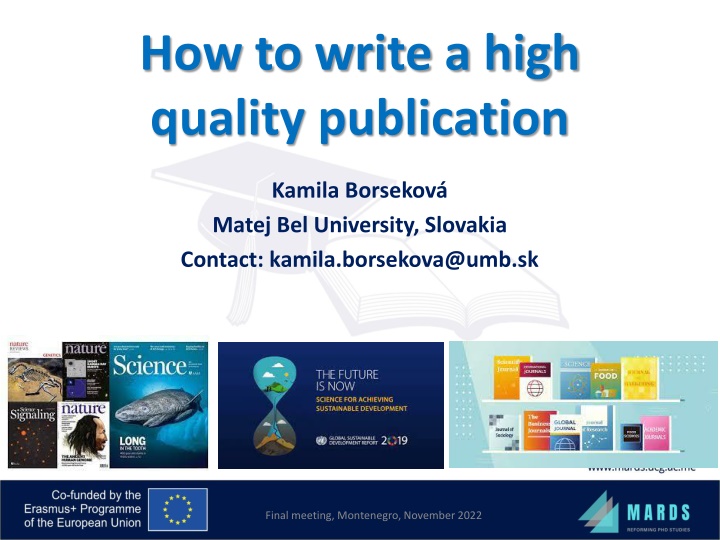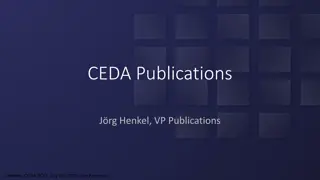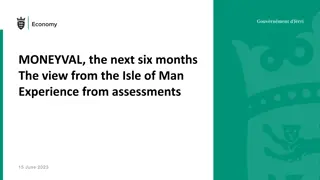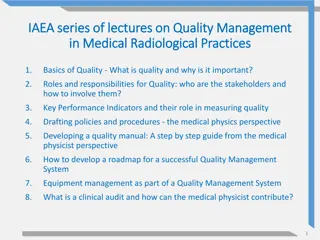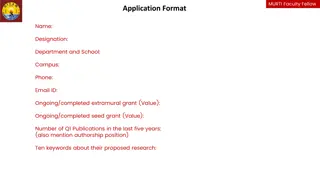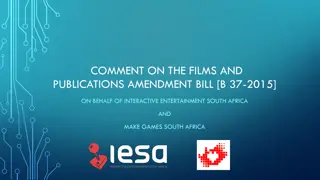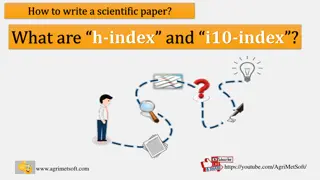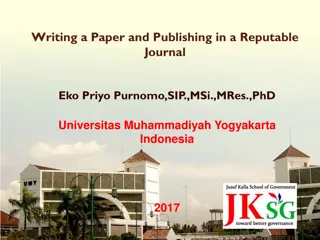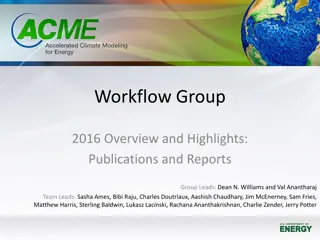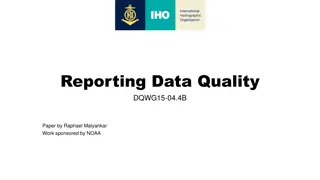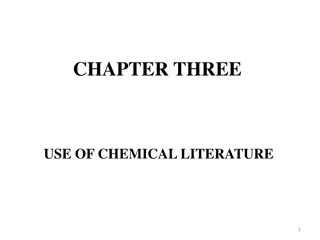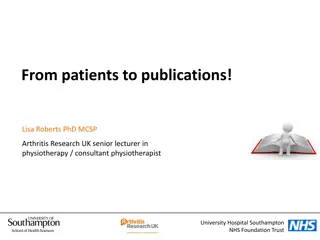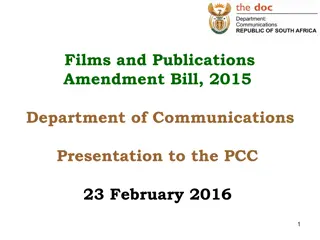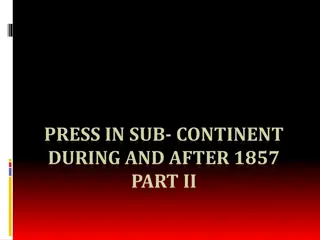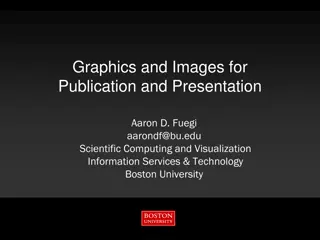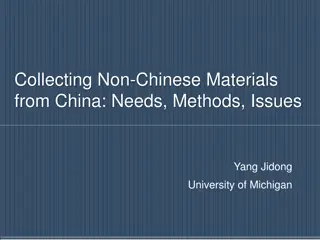Crafting High-Quality Publications
Crafting a high-quality publication involves solid scholarship and effective presentation to reach the right audience. Learn the key phases of the article publishing process, from manuscript writing to dealing with reviewers' comments. Discover when you're ready to write a manuscript and how to define your paper story and key message. Articulate goals, identify gaps in knowledge, and target the most appropriate journals to share your research effectively.
Download Presentation

Please find below an Image/Link to download the presentation.
The content on the website is provided AS IS for your information and personal use only. It may not be sold, licensed, or shared on other websites without obtaining consent from the author.If you encounter any issues during the download, it is possible that the publisher has removed the file from their server.
You are allowed to download the files provided on this website for personal or commercial use, subject to the condition that they are used lawfully. All files are the property of their respective owners.
The content on the website is provided AS IS for your information and personal use only. It may not be sold, licensed, or shared on other websites without obtaining consent from the author.
E N D
Presentation Transcript
How to write a high quality publication Kamila Borsekov Matej Bel University, Slovakia Contact: kamila.borsekova@umb.sk Final meeting, Montenegro, November 2022
How do you get published in a good journal? Publishing a paper in a good journal is not about being lucky or knowing the right people, and it doesn t require magic either. Getting published in a good journal requires solid scholarship that is presented in an excellent way to the right audience. Instead of dumping your good work in a journal where nobody will see it, you ll aim to publish it in a good journal! Final meeting, Montenegro, November 2022
Article publishing process Highly competitive There is no "one-size-fits-all" guide The process has 3 basic phases: I. Manuscript writing phase II. Manuscript submission phase III. Dealing with reviewers' comments Final meeting, Montenegro, November 2022
When am I ready to write a manuscript? Does my data tell a story or are they merely pieces of information? (you have to have an answer to a clearly articulated question!) Do the results I achieved move the state-of- knowledge for the field forward? (don t just do it because it could be done!) Is the information I have collected relevant to others? (who really cares anyway?) Final meeting, Montenegro, November 2022
I. ARTICLE WRITING PHASE Final meeting, Montenegro, November 2022
Define your paper story and its key message A good paper, like any good text, is not an accumulation of facts and numbers interrupted by figures and graphs. Good journals prefer you tell an original story. Stories are easier to remember than single facts and they help place your work in a larger context. There needs to be a clear message readers don t want to guess what you are trying to tell them. Final meeting, Montenegro, November 2022
Telling your story Articulate goals and hypotheses Identify gaps in current understanding Emphasize how your work will add new knowledge Know/define your target audience Target the most appropriate journal Attention to detail and format Final meeting, Montenegro, November 2022
Scientific organization Introduction: What question was addressed? Methods: How was the question studied? Results: What were your findings? Discussion: What do these findings mean? Abstract: Summarizes the main points above without going into detail Title: Goes last.. Final meeting, Montenegro, November 2022
Writing the introduction Sufficient background Motivation and rational Outline specific aims Accessible and interesting Broad/general to focused/specific Define specialized terms and abbreviations Final meeting, Montenegro, November 2022
Materials and methods Concise but include full details Use the past tense Enough information so study can be reproduced Outline sites and sampling strategy Order methods chronologically Sub-headings can help organize Use references, tables and figures where appropriate Final meeting, Montenegro, November 2022
Present robust and reliable findings Your story provides the context for your research and the message that you want to communicate. The power and credibility of your message deeply depends on the reliability and robustness of your approach. When you address a relevant question in your paper, it is essential that your readers can understand how you approached the question and what you found out. Make sure you explain in full detail and without gaps how you ve conducted your research, and then present results that you can confidently rely upon. The journal space is limited, so consider presenting some of the specific material in an online appendix. Final meeting, Montenegro, November 2022
Reporting the results Tables and figures are a good way to summarize information Concise description of experimental findings Avoid redundant figures etc. Summarize most important points and refer to raw data in the table or supplementary information Include appropriate statistical information Avoid redundancy Final meeting, Montenegro, November 2022
Figures and tables Make your figures legible and easy to read Label axes appropriately Avoid a lot of blank space Use figures to convey the most important results Use the figure legend to describe what the figure conveys Use tables and supplementary data to include raw data and summary statistics Final meeting, Montenegro, November 2022
Writing the discussion Discuss but do not restate the results Point out exceptions to main findings Acknowledge caveats or limitations Relate main findings to questions raised in the introduction Emphasize significance of your findings Avoid over-interpretation Acknowledge contributions and funding sources Final meeting, Montenegro, November 2022
References Check your references carefully Format determined by the journal Citations in text: name, year Multiple authors: use et al., year Check citation order system: alphabetical or chronological Check journal abbreviation styles Final meeting, Montenegro, November 2022
Writing an abstract Miniature version of the paper Word limit Reflect content of the paper Content Specific objectives Principle methods Summary of results Main conclusions Final meeting, Montenegro, November 2022
Adopt writing style to fit your audience There is not one scientific style that fits all papers and all journals. You ve decided on a specific audience and a specific journal, now try to understand how research results are communicated within this community. Read other papers from that community in your chosen journal. You will see that some papers present a lot of details on a specific method, while others don t because it is common knowledge for the audience. That means instead of applying your preferred writing style, put yourself in the position of your audience: What information do they need and how will they best understand it? Final meeting, Montenegro, November 2022
Edit your text carefully Even if your story is a strong one and your results are mind-blowing, if your text is not well written, you have no chance of making it into a good journal. If your text is poorly written or not well edited, they will not read far enough to identify the value of your paper. Good journals get many submissions. They can select the papers they want to publish. If they get a paper that doesn t read well, they can assume that the research presented is of similar quality. Spend enough time to edit your paper, i.e. work on the content of each paragraph, the clarity of your messages, the expressions that you use, check whether your audience is familiar with them, proofread the language, and check the length of your text. A text that reads fluently is more convincing than a complicated one that requires several reads. Final meeting, Montenegro, November 2022
Ask for feedback before you submit You want the journal and its audience to support your paper and publish it. Of course you think your paper is good enough to meet their standards, but can you be sure? You shouldn t risk paper rejection because of avoidable mistakes. Ask an experienced colleague from your field of research to read through your manuscript and provide you with feedback. An independent colleague can more easily identify weak parts in your paper, and once you know them, you can fix these issues before you submit. Final meeting, Montenegro, November 2022
Tips and tricks Think about the manuscript in advance, focus on the story that you present logically rather than chronologically Do not try to write and edit the paper at the same time Present your motivation clearly and comprehensibly right from the start and make sure it is in line with theory, methodology and conclusions Ask one of your colleagues to give you feedback Pay attention to the language level Review other articles Don't forget foreign readers Don't try to "squeeze" the entire dissertation into a 6,000- word article Final meeting, Montenegro, November 2022
Tips and tricks Title not very long, short and concise, try to write it so that it is interesting Abstract - not very long, you don't have to mention all the details, but it should contain key results and highlight how your article is original, innovative (see word limit) Introduction why you decided to write about this/do this particular research try to put it in an interesting perspective and write it in an engaging way Results and Discussion - what you did - explore what this means and why it is important Conclusion a robust summary of what you have managed to research, an outline of further research that can be built on your results, or use in practice Experimental part/detailed description of the methodology Use one/two references from the journal you are trying to publish in Final meeting, Montenegro, November 2022
II. MANUSCRIPT SUBMISSION PHASE Final meeting, Montenegro, November 2022
Where to submit Suitable match for the journal Appeal to the readership Quality versus quantity Journal impact factors Number of citations Open access versus subscription only Speed of publication Likelihood of success Final meeting, Montenegro, November 2022
How to find the right journal for your paper Paper topic and journal scope Readership of the journal Identify potential journals using keywords and databases Google Scholar Scopus Web of Science Directory of Open Access Journals In this step, you will get many journal names that you can list as potential journals for your paper. Final meeting, Montenegro, November 2022
How to find the right journal for your paper Use journal finder tools They work by comparing semantic elements from the information that you put into the tool and look for the best fit of these expressions inside the publisher s journal portfolio. Typically, you can copy your abstract, title, or keywords or even the entire paper into the tool. Elsevier s Journal Finder, Springer Nature s Journal Suggester, IEEE s Publication Recommender, Wiley s Journal Finder, Taylor & Francis Journal Suggester, Make an inventory List and keep track of all potential journal names. Double-check that you ve excluded so-called predatory journals as they can harm your career development (Check the post on Predatory Journals for more information). Final meeting, Montenegro, November 2022
How to find the right journal for your paper Browse journal information Research the journals in your table. Focus on how these journals are doing, what they specialise in, and how relevant they would be to your paper. The journal s website is the prime source of information. Check their description of the Aims & Scope (also called the About section). Here, they describe what they re interested in publishing. The website will also inform you on how the journal performs on relevant metrics. You can identify potential publication fees, and see the topics of the published papers in each journal to get an idea of what sort of research they are publishing. Send a pre-submission inquiry For some journals, it might be difficult to find out what they re really interested in. Send an email to the editorial office that briefly describes what your paper is about, and ask them whether they would in general be interested in such a topic. A pre-submission inquiry can save a lot of time! Decide and go for it Final meeting, Montenegro, November 2022
Cover letter Together with the Abstract and Conclusion, the cover letter is the first thing that the editor and then the reviewers look at Write it briefly and clearly, the longer the cover letter, the greater the chance that the reviewer will miss something important Focus on these points: Why is the topic important Why are your research results significant What is the key result How is this a shift from current knowledge/research Why did you choose this journal Why the readers will read your article State the status of your manuscript - exclusivity Suggest reviewers (if possible) Final meeting, Montenegro, November 2022
Tips and tricks Choose a suitable journal (focus, go through several issues and articles) Think about how quickly you need your article to be published and adapt the choice of journal accordingly Always follow the instructions when submitting an article and respect the instructions for the technical editing of the article - tables, sources, graphs according to the journal's requirements Do not repeat the abstract in the cover letter, state the arguments "in addition" and why your article is suitable for the magazine A common reason for rejection from an editor is a lack of context and a lack of clarity as to why your research is important Don't overestimate your methodology Final meeting, Montenegro, November 2022
Tips and tricks Always study the focus of the journal in detail and consider whether your research/article is a good fit In the cover letter, describe exactly how it reflects the focus of the journal and how your article is beneficial to the magazine Choose good conferences that have quality publication outputs (ideally a special issue of a quality journal registered in Scopus/WOS or books from a prestigious publishing house) Follow calls for publications (e.g. on Research Gate) Choose high-quality journals (check the quality in Scimago, WOS, or Scopus, don't rely only on the journal's website) Consider the "readability" of your publication Consider your options and try to achieve the highest possible quality Consult with your supervisor/s or colleagues who already have experience Don't let the first failure discourage you, learn from it! Final meeting, Montenegro, November 2022
III. DEALING WITH REVIEWERS' COMMENTS Final meeting, Montenegro, November 2022
Dealing with reviewers comments Peer reviewed process - at least two reviewers + editor Respond objectively and calmly to (ideally all) reviewers' comments Edit and submit the article again - don't give up when you've come that far! It is acceptable not to process some of the comments if you have a good reason for doing so or if they are not correct Final meeting, Montenegro, November 2022
Tips and tricks: What editor and reviewers focus on Editor: After an initial check that your article meets formal requirements, language quality, scope of the journal and length, he/she will then look at: Is the so-called novelty high enough? Is your article original comparing to already published works? Is your research important to other researchers in the field? Is your article interesting to journal readers? Final meeting, Montenegro, November 2022
Tips and tricks: What editor and reviewers focus on Editor Cover letter Conclusion, summary Keywords References Abstract Visual information If the manuscript interested me, it will interest also readers Reviewer/s Is the motivation clear? Is motivation important? Is the article original? Does the article have a clearly defined objective? Are the article's conclusions supported by the data? Are conclusions important? (are they interesting?) Does the article have any ethical issues? Are there any inconsistencies or errors in the article? Is there something missing in the article? Should something be removed? Is the overall presentation of the article/data/conclusions clear? Final meeting, Montenegro, November 2022
If your article is not published the first try, definitely do not give up, but learn from it and try again!
Tips how to publish Pre-test publishing Present your research, discuss it and ask for feedback! Read the recommendations before publishing in quality journals and respect them! Make sure that your publication will not be rejected due to formal deficiencies Have a look on existing publications to get the picture Sufficient period of time (minimum 1 year!) Don't let your data get old Proof reading if you are not confident in a foreign language Don't look for the easiest way, focus on quality Discuss the possibilities of a quality publication with your supervisor/s Be active YOU! Final meeting, Montenegro, November 2022
INVESTING TIME AND EFFORT IN A QUALITY PUBLICATION IS WORTH IT! Final meeting, Montenegro, November 2022
THANK YOUR FOR YOUR ATTENTION AND QUESTIONS ARE MORE THAN WELCOME! Final meeting, Montenegro, November 2022
Assignment # 1 Writing an abstract (300 word limit) Brief introduction Identification of the gap in our understanding or motivation for the study Summarize the sampling strategy and/or principal methods used Provide an overview of the most important results Discuss the significance of the findings and prospects for future work Keywords Final meeting, Montenegro, November 2022
Assignment # 2 Prepare the list of journals suitable for your paper Final meeting, Montenegro, November 2022
